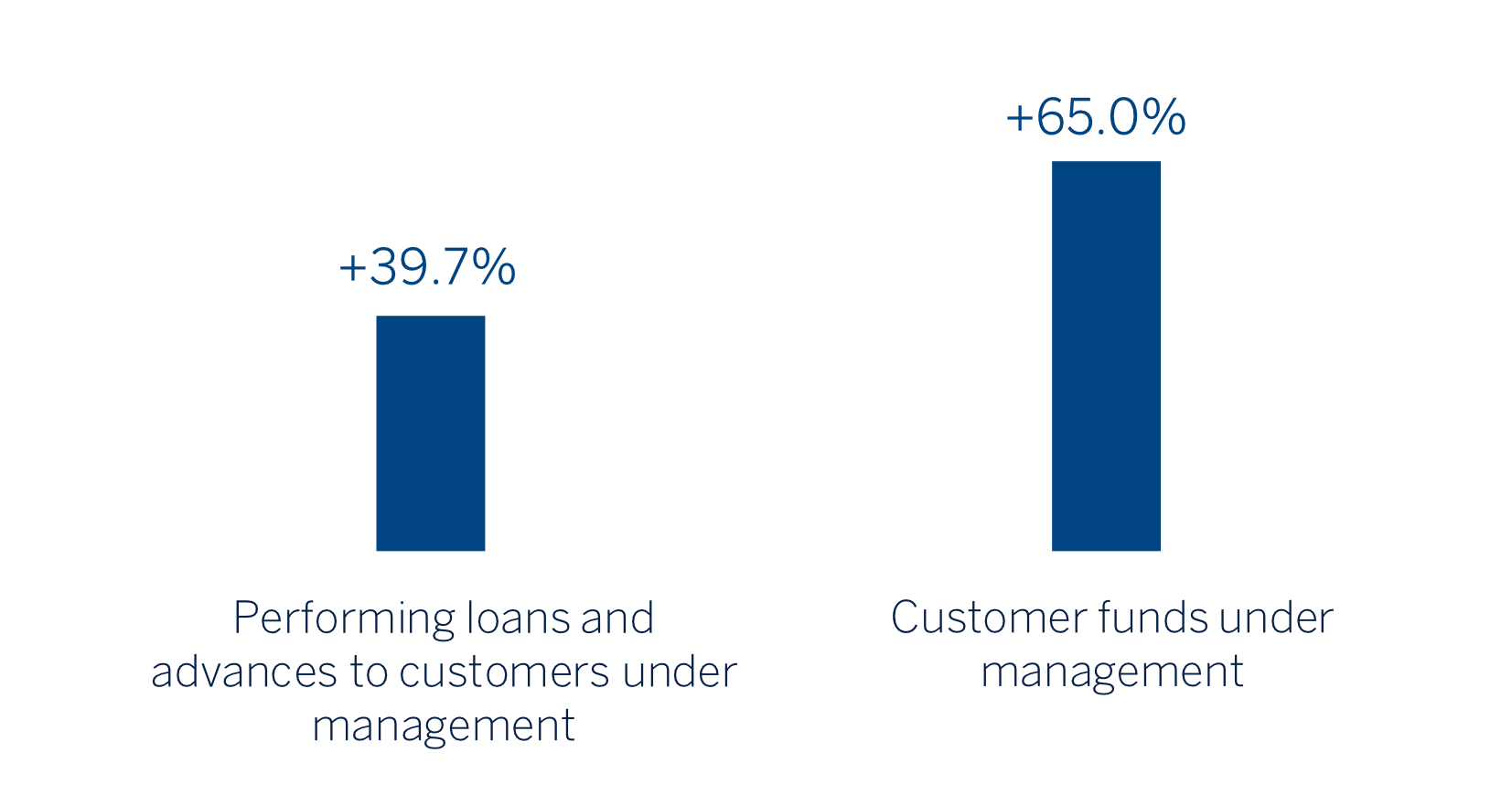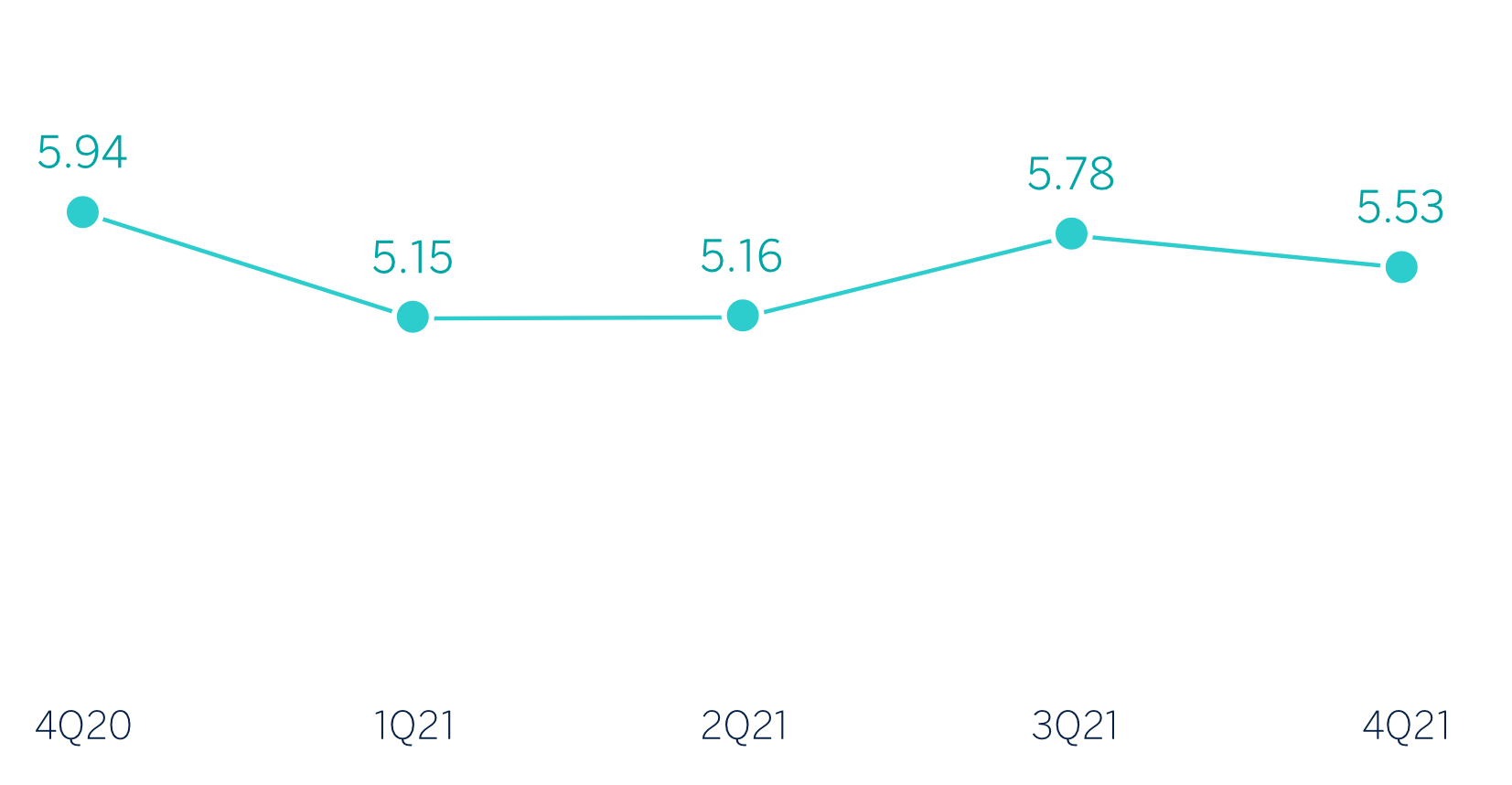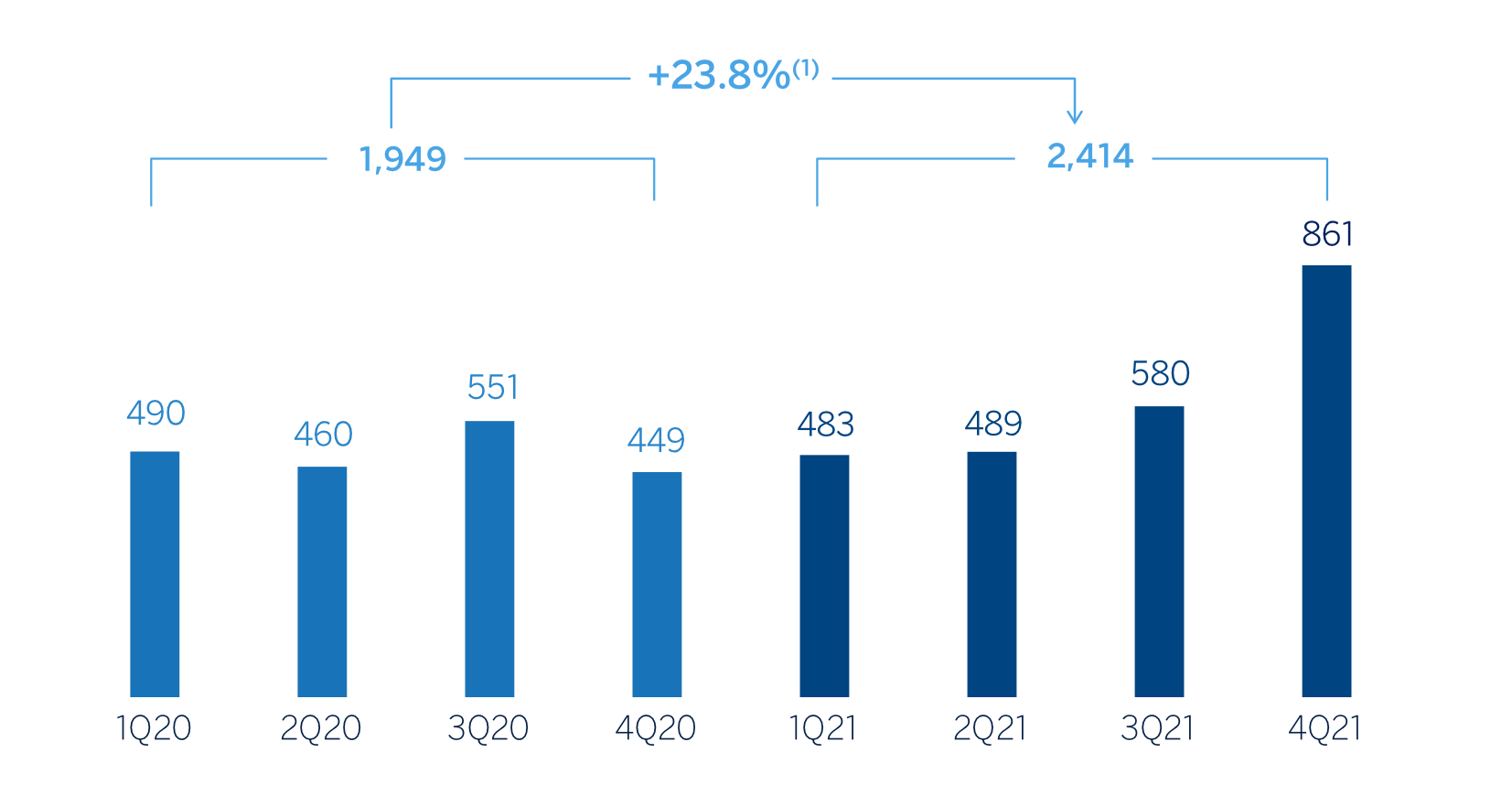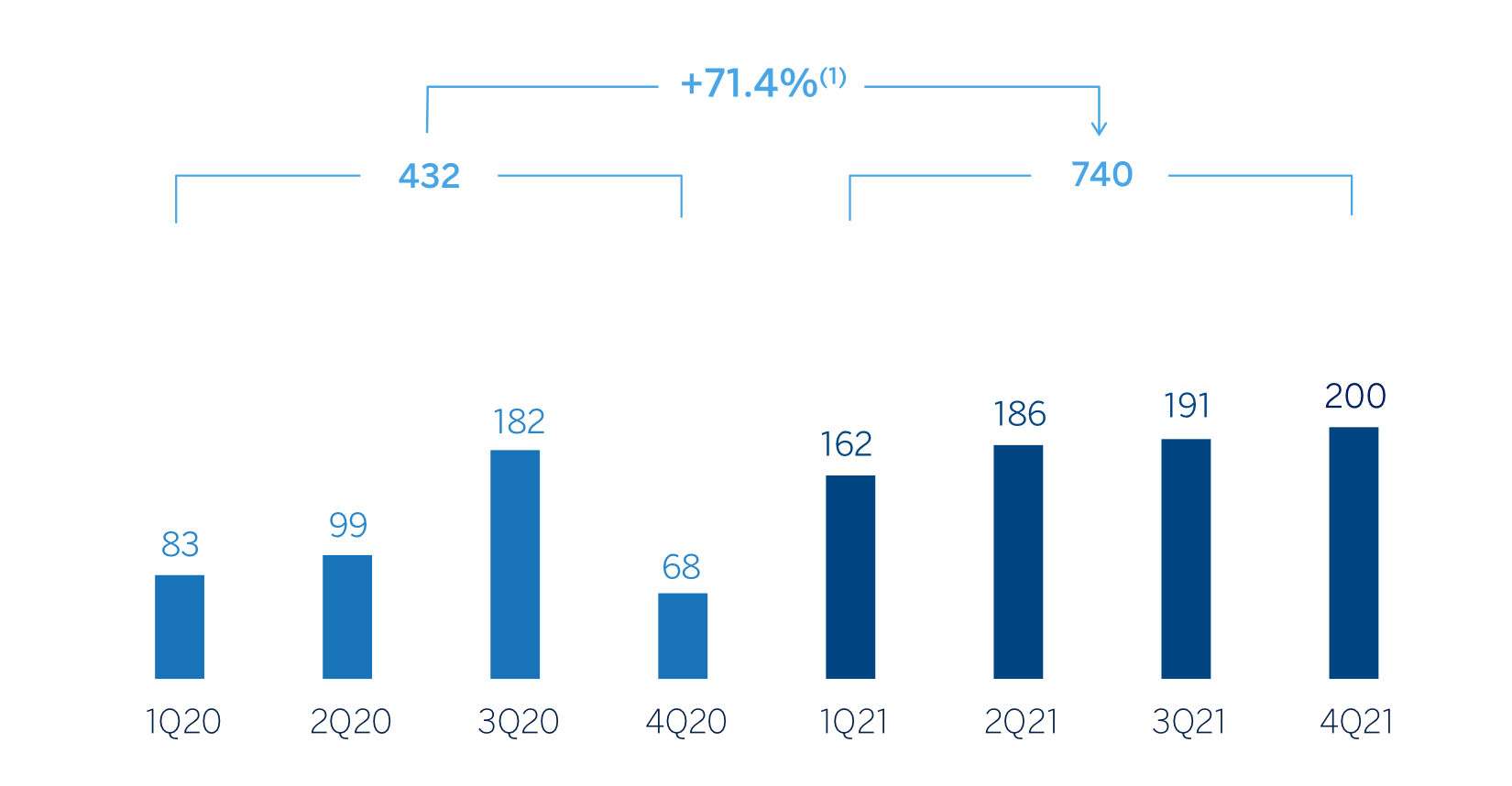Turkey
Highlights
- Activity driven by Turkish lira loans and deposits
- Year-on-year growth in recurring income and NTI
- Year-on-year decrease in the cost of risk
- Net attributable profit growth driven by higher revenues and lower impairment on financial assets
Business activity (1)
(VARIATION AT CONSTANT EXCHANGE RATE COMPARED TO 31-12-20)

(1) Excluding repos.
Net interest income/ATAs
(Percentage. Constant exchange rate)

Operating income
(Millions of euros at constant exchange rate)

(1) At current exchange rate: -5.1%
Net attributable profit (LOSS)
(Millions of euros at constant exchange rate)

(1) At current exchange rate: +31.3%
Financial statements and relevant business indicators (Millions of euros and percentage)
| Income statement | 2021 | ∆% | ∆% (1) | 2020 |
|---|---|---|---|---|
| Net interest income | 2,370 | (14.8) | 11.2 | 2,783 |
| Net fees and commissions | 564 | 10.6 | 44.4 | 510 |
| Net trading income | 413 | 81.9 | 137.4 | 227 |
| Other operating income and expenses | 74 | 39.4 | 81.9 | 53 |
| Gross income | 3,422 | (4.2) | 25.0 | 3,573 |
| Operating expenses | (1,008) | (2.1) | 27.8 | (1,029) |
| Personnel expenses | (593) | 5.8 | 38.0 | (561) |
| Other administrative expenses | (297) | (7.0) | 21.4 | (319) |
| Depreciation | (118) | (20.8) | 3.3 | (150) |
| Operating income | 2,414 | (5.1) | 23.8 | 2,544 |
| Impairment on financial assets not measured at fair value through profit or loss | (494) | (44.8) | (27.9) | (895) |
| Provisions or reversal of provisions and other results | 33 | n.s. | n.s. | (127) |
| Profit (loss) before tax | 1,953 | 28.3 | 67.4 | 1,522 |
| Income tax | (455) | 19.9 | 56.5 | (380) |
| Profit (loss) for the year | 1,498 | 31.1 | 71.1 | 1,142 |
| Non-controlling interests | (758) | 30.9 | 70.8 | (579) |
| Net attributable profit (loss) | 740 | 31.3 | 71.4 | 563 |
| Balance sheets | 31-12-21 | ∆% | ∆% (1) | 31-12-20 |
|---|---|---|---|---|
| Cash, cash balances at central banks and other demand deposits | 7,764 | 41.7 | 136.9 | 5,477 |
| Financial assets designated at fair value | 5,289 | (0.8) | 65.8 | 5,332 |
| Of which loans and advances | 295 | (29.0) | 18.7 | 415 |
| Financial assets at amortized cost | 41,544 | (11.1) | 48.7 | 46,705 |
| Of which loans and advances to customers | 31,414 | (15.8) | 40.8 | 37,295 |
| Tangible assets | 623 | (30.8) | 15.7 | 901 |
| Other assets | 1,025 | (12.4) | 46.4 | 1,170 |
| Total assets/liabilities and equity | 56,245 | (5.6) | 57.8 | 59,585 |
| Financial liabilities held for trading and designated at fair value through profit or loss | 2,272 | (2.7) | 62.6 | 2,336 |
| Deposits from central banks and credit institutions | 4,087 | 20.9 | 102.1 | 3,381 |
| Deposits from customers | 38,341 | (2.6) | 62.9 | 39,353 |
| Debt certificates | 3,618 | (10.4) | 49,8 | 4,037 |
| Other liabilities | 2,166 | (49,7) | (16,0) | 4,308 |
| Regulatory capital allocated | 5,761 | (6.6) | 56.1 | 6,170 |
| Relevant business indicators | 31-12-21 | ∆% | ∆% (1) | 31-12-20 |
|---|---|---|---|---|
| Performing loans and advances to customers under management (2) | 30,610 | (16.5) | 39.7 | 36,638 |
| Non-performing loans | 2,995 | (5.9) | 57.3 | 3,183 |
| Customer deposits under management (2) | 38,335 | (2.6) | 62.9 | 39,346 |
| Off-balance sheet funds (3) | 3,895 | 13.7 | 90.1 | 3,425 |
| Risk-weighted assets | 49,718 | (6.2) | 56.7 | 53,021 |
| Efficiency ratio (%) | 29.5 | 28.8 | ||
| NPL ratio (%) | 7.1 | 6.6 | ||
| NPL coverage ratio (%) | 75 | 80 | ||
| Cost of risk (%) | 1.33 | 2.13 |
(1) At constant exchange rate.
(2) Excluding repos.
(3) Includes mutual funds and other off-balance sheet funds.
Macro and industry trends
Activity indicators suggest that GDP has continued to grow strongly in the fourth quarter of 2021, supporting a revision of BBVA Research’s growth estimate for 2021 from 9.5% to around 10.8%. Strong demand, as well as the sharp depreciation of the Turkish lira following the interest rate cuts announced in recent months, contributed to a very significant increase in annual inflation to 36.1% in December 2021. According to BBVA Research's estimates, growth could moderate to around 3.5% in 2022. However, the economic environment is highly volatile given the combination of high inflation (on average it could be around 50% in 2022), very negative real rates environment, pressure on the Turkish lira and high external financing needs.
With regard to the banking system, based on data as of December 2021 the total volume of lending in the system increased by 37% since December 2020 in local currency (+20% in the Turkish lira portfolio and -5% in the foreign currency loan portfolio), while deposits grew by 54%, included in these growth rates are the effect of inflation and the depreciation of the Turkish lira. The deposit dollarization increased to 64.5% (55.3% the previous year and 55.1% as of September 2021), mainly due to the depreciation of the Turkish lira. The system's NPL ratio stood at 3.16% at the end of 2021 (4.05% at the end of 2020 and 3.59% as of September 2021).
Unless expressly stated otherwise, all comments below on rates of changes for both activity and income, will be presented at constant exchange rates. These rates, together with changes at current exchange rates, can be observed in the attached tables of the financial statements and relevant business indicators.
Activity
The most relevant aspects related to the area’s activity during 2021 were:
- Lending activity (performing loans under management) increased by 39.7% between January and December 2021, driven by the growth in Turkish lira loans (+28.1%). This growth was supported by consumer loans, thanks to the strong origination in General Purpose Loans, and also by credit cards, mortgages and commercial loans. Foreign currency loans (in U.S. dollars) decreased in 2021 (-13.3%).
- In terms of asset quality, the NPL ratio increased by 57 basis points to 7.1% compared to the end of September 2021. In the quarter, there was positive performance in recoveries and repayments, as well as partial write-offs in the wholesale portfolio and retail portfolio sales; almost offsetting the higher NPL entries mainly due to the reclassification resulting from the implementation of the new definition of default. The NPL coverage ratio stood at 75% as of December 31, 2021, which represents a decrease of 311 basis points in the quarter, mainly due to the evolution of non-performing loans.
- Customer deposits under management (68% of total liabilities in the area as of December 31, 2021) remained as the main source of funding for the balance sheet and increased by 62.9%. Especially noteworthy is the positive performance of Turkish lira demand deposits (+41.8%), which represent 29% of total customer deposits in local currency, as well as time deposits (+18.7%). Foreign currency deposits (in U.S. dollars) increased by 5.1%. For its part, the evolution of off-balance sheet funds (+90.1%) also stood out.
The most relevant developments in the area’s activity in the fourth quarter of 2021 were:
- Lending activity growth (performing loans under management) was above the previous quarter (+18.6%), as a result of the growth in Turkish lira loans (+4.7%), while foreign currency loans (in U.S. dollars) increased its rate of contraction in the quarter (-5.6%). In the Turkish lira loan portfolio the performance of consumer loans and credit cards stood out.
- Total funds under management showed a positive quarterly evolution (+36.3%), driven by the growth of deposits, both in local and foreign currencies.
Results
Turkey generated a net attributable profit of €740m in 2021, 71.4% higher than the previous year, which was impacted by a strong increase in the impairment on financial assets due to the COVID-19 pandemic and also supported by higher contribution from recurring income and NTI in 2021. Taking into account the effect of the depreciation of the Turkish lira over the period, the results generated by Turkey increased by 31.3%.
The most significant aspects of the year-on-year evolution in the area's income statement at the end of December 2021 were:
- Net interest income increased by 11.2%, mainly due to larger loan volumes and also due to a higher contribution from inflation-linked bonds. This was partly offset by the contraction of the customer spread during 2021 and by higher financing costs.
- Net fees and commissions recorded significant growth (+44.4%) mainly driven by the positive performance in payment systems, money transfer, brokerage and guarantees.
- NTI performed significantly well (+137.4%), mainly due to the earnings of the Global Markets unit, as well as gains from securities transactions
- Other operating income and expenses increased by 81.9% in 2021, mainly due to the greater contribution of the subsidiaries of Garanti BBVA, most notably the leasing operations.
- Operating expenses increased by 27.8%, impacted by the higher average annual inflation rate (above 19%), the depreciation of the Turkish Lira and increased activity. On the other hand, there was a reduction in some discretionary expenses in 2020 due to COVID-19, affecting the year-on-year evolution. Nevertheless, the efficiency ratio remained low (29.5%).
- Impairment on financial assets decreased by 27.9% compared to those registered in 2020, mainly due to the negative impact of the deterioration in the macroeconomic scenario as a result of the outbreak of the COVID-19 pandemic in March 2020, as well as the improvement of said scenario in 2021. In the fourth quarter of 2021, there was an increase in the coverage of customers sensitive to exchange rate fluctuations and higher requirements for provisions were recorded after a recalibration of wholesale risk models, reflecting greater sensitivity to currency evolution. As a result, the cumulative cost of risk at the end of December 2021 has decreased to 1.33% from 2.13% a year earlier.
- The provisions and other results line closed December with a profit of €33m, compared to the loss of €-127m recorded in the same period of the previous year, mainly thanks to lower provisions for special funds and contingent liabilities and commitments and capital gains from the sale of real estate assets.
In the last quarter of 2021, excluding the exchange rate effect, Turkey generated a net attributable profit of €200m, which represents an increase of 5.0% compared to the previous quarter, mainly due to the positive evolution of the net interest income, which increased by 44.0%, driven by improvement in customer spreads due to lower Turkish lira cost of funding and the higher contribution of inflation-linked bonds. In addition, Turkish lira depreciation also supported net interest income in the quarter because of foreign currency position of the balance sheet. All the aforementioned was in part offset by an increase in the impairment of financial assets in the quarter, an increase in operating expenses (+45.8%) and the upward adjustment of the effective tax rate, resulting from the tax reform implemented in April 2021.
